The value of the 1909 Wheat penny depends on several factors. For example, coins with a red hue tend to be more valuable than those with brown toning. Additionally, VDB variety pieces are more sought after than regular ones.
It is estimated that only about 16,000 of these coins remain in uncirculated condition, and just 3,000 of them retain a red color with an MS 65 grade or higher. The situation is even more complex for proof coins, as fewer than 150 red specimens have been graded MS 65 or higher, making them incredibly rare and valuable.
1909 Wheat Penny Value Chart
| Condition | 1909 Penny | 1909 S Penny | 1909 VDB Penny | 1909 S VDB Penny | 1909 S/S Penny |
|---|---|---|---|---|---|
| Good | $4 | $95 | $18 | $860 | $95 |
| Very good | $4 | $110 | $18 | $1,000 | $115 |
| Fine | $5 | $125 | $19 | $1,150 | $150 |
| Very fine | $6 | $165 | $19 | $1,350 | $175 |
| Extra fine | $7 | $200 | $20 | $1,450 | $215 |
| AU | $14 | $250 | $22 | $1,675 | $250 |
| MS 60 | $28 | $350 | $30 | $2,200 | $330 |
| MS 63 | $45 | $450 | $55 | $2,650 | $450 |
| PR 63 | $600 | / | $17,500 | / | / |
Values are for brown-toned coins.
History of the 1909 Wheat Penny
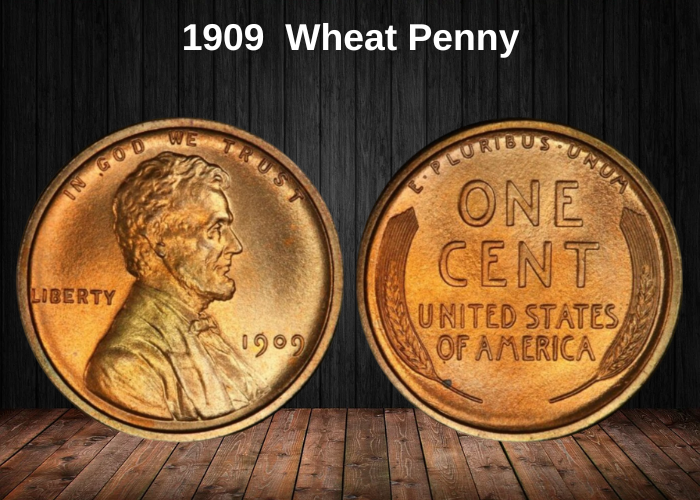
Wheat pennies first entered circulation in 1909 to commemorate the centennial of Abraham Lincoln’s birth. This coin was also the first in American history to feature a real person on the obverse, replacing the traditional allegorical figures.
However, even these coins were not exempt from controversy. Critics of the new design sought reasons to object, one of the main issues being the prominent initials of the designer, which were seen as excessive self-promotion.
As a result, all cents minted after the initial 1909 batch were struck without the designer’s initials until 1918. This distinction makes the first editions particularly desirable among collectors.
1909 Wheat Penny Types
| Location | Year | Mintage |
|---|---|---|
| Philadelphia | 1909 Penny | 72,700,000 |
| Philadelphia | 1909 Penny Proof | 2,618 |
| Philadelphia | 1909 Penny VDB | 27,995,000 |
| Philadelphia | 1909 Penny Proof VDB | 1,194 |
| San Francisco | 1909 S Penny | 1,825,000 |
| San Francisco | 1909 S Penny VDB | 484,000 |
| Total | / | 103,007,812 |
Today, only a few tens of thousands of these coins remain in mint condition out of the more than 100 million originally produced. The survival rate for proofs is even lower, with just 272 known specimens in mint state, including only 137 graded MS 65 or higher.
Features of the 1909 Wheat Penny Value
The 1909 penny was designed by Victor Brenner. During its first year of production, two distinct versions were minted—one featuring his VDB initials on the reverse and another without them.
The obverse of the 1909 penny
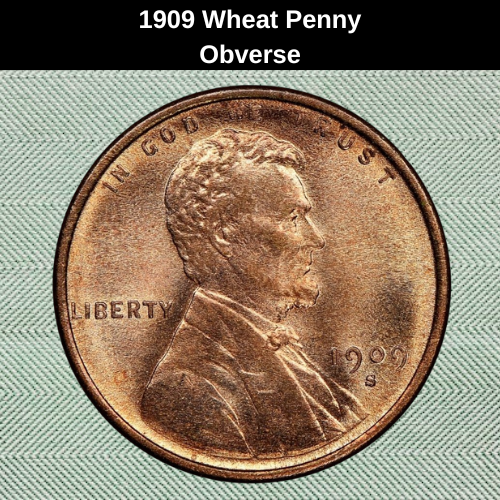
The obverse of the 1909 penny features a portrait of Abraham Lincoln, the 16th President of the United States, who played a crucial role in shaping the nation. His right-facing profile was the first-ever depiction of a real person on an American coin.
This side also includes the minting year and, on coins struck in San Francisco, a mint mark (S). The VDB varieties display the designer Victor D. Brenner’s initials beneath Lincoln’s shoulder.
The reverse of the 1909 penny

The reverse of the 1909 Wheat penny features an elegant yet simple design, displaying two wheat ears, the Latin motto E·PLURIBUS·UNUM, the denomination (ONE CENT), and the country’s name (UNITED STATES OF AMERICA).
1909 Wheat Penny Specifications
| Feature | Details |
|---|---|
| Composition | 95% copper, with zinc or tin |
| Weight | 3.11 g (0.10970 oz) |
| Thickness | 1.52 mm (0.0598 in) |
| Diameter | 19.05 mm (0.75 in) |
| Edge | Plain |
| Face Value | One cent ($0.01) |
| Shape | Round |
Other features of the 1909 penny
The 1909 pennies are small U.S. coins with a face value of $0.01. They are made of a 95% copper alloy, with the remaining 5% composed of zinc or tin. These coins have a thickness of 1.52 mm (0.0598 inches), a diameter of 19.05 mm (0.75 inches), and a weight of 3.11 grams (0.10970 ounces).
Grading of the 1909 Wheat Penny
The grading process for the 1909 penny follows the same standards as other coins, but there are key details that can significantly impact its value.
Since these pennies were struck in the first year of production, they exist in two main varieties—with and without the designer’s VDB initials. Additionally, some feature well-known errors, such as the S over horizontal S (RPM), which is specific to coins minted in San Francisco.
1909 Wheat Penny Grading Scale
| # | Grade |
|---|---|
| 1 | Basal State-1 |
| 2 | Fair |
| 3 | Very Fair |
| 4-6 | Good |
| 7-10 | Very Good |
| 12-15 | Fine |
| 20-30 | Very Fine |
| 40 | Extremely Fine |
| 50 | About Uncirculated |
| 60 | Mint State |
| 65 | Mint State |
| 70 | Mint State |
To determine your coin’s precise grade and value, refer to our grading guides. Evaluating your penny accurately is essential for understanding its true worth.
The 1909 Wheat Penny Value Guides
1909 No Mint Mark Wheat Penny Value (with and without VDB)
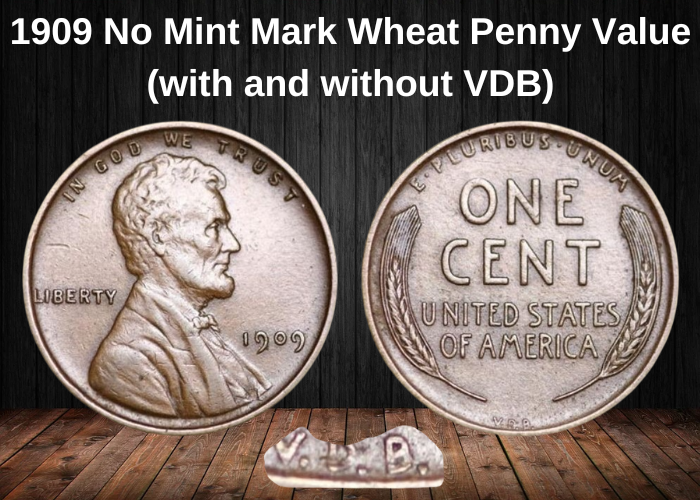
As mentioned earlier, the Philadelphia Mint produced four distinct types of pennies in 1909. Two of these were regular circulation coins, one featuring the designer’s initials VDB and one without, which influences their prices. The mintage for the coins without VDB was 72,700,000.
The value of these pennies varies based on their color and condition. For instance:
- Brown coins range from $3 to $10 in circulated condition. In mint state, these can be priced between $28 and $125, depending on their appearance.
- Red-brown coins, graded from MS 63 to MS 66, can cost anywhere from $50 to $240.
- Coins graded MS 67 are rare and are valued at approximately $2,500.
The Philadelphia Mint also minted 27,995,000 VDB pennies in 1909.
- Brown VDB pennies are typically valued between $30 and $110, depending on their condition.
- Red-brown VDB coins are more expensive, ranging from $30 to $2,200, depending on their quality. However, MS 68-grade VDB pennies are highly sought after and can fetch around $23,000.
The most valuable 1909 VDB red pennies typically range in price from $35 to $4,000.
- MS 68 specimens, being rare, can command around $60,000.
1909 Wheat Penny proofs Value (with and without VDB)
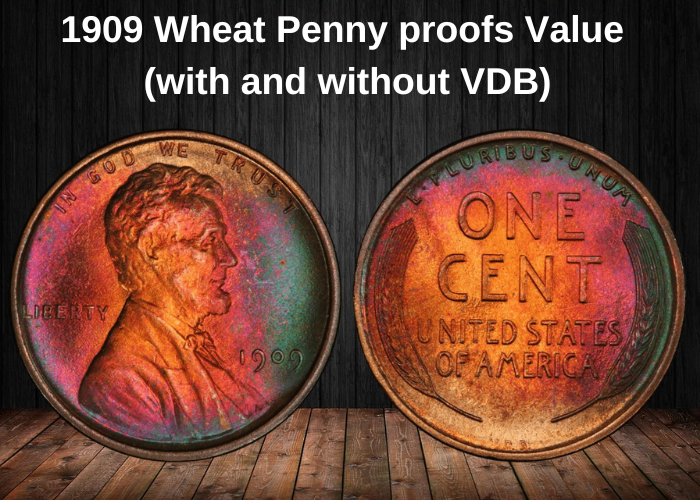
In addition to the regular circulation coins, the Philadelphia Mint produced 2,618 proof pennies without the designer’s initials and 1,194 proof VDB pennies in 1909.
- Standard brown proof coins without VDB can range in value from $340 to $6,500.
- However, rare proof coins with VDB initials command significantly higher prices, typically ranging from $7,000 to $45,000, depending on their condition.
For red-brown proof coins without VDB, prices can vary from $450 to $11,500. Conversely, red-brown proof pennies with VDB initials are priced between $8,750 and $275,000, based on their preservation.
As with regular coins, red proof pennies are the most desirable and collectible, with prices ranging from:
- $775 for PR 63-graded coins to
- $11,500 for PR 67+-graded specimens.
The most valuable coins in this set are red VDB proof pennies with a high luster. Their prices are exceptionally high, ranging from $13,500 to $15,000 for PR 62-graded pieces, and can go as high as $200,000 for PR 67-graded coins.
1909 S Wheat Penny Value (with and without VDB)

The San Francisco Mint produced 1,825,000 pennies in 1909, with an additional 484,000 pennies stamped with the designer’s VDB initials at the reverse base. These coins can be categorized into three color types, each affecting their price.
Regular Brown 1909 Pennies
- Value range: $65 to nearly $9,000, depending on their condition.
1909 VDB Pennies
- Circulated VDB pennies are priced between $850 and $1,650.
- Mint state VDB pennies (graded MS 60) start at $2,200 and can go up to $25,000 for MS 67-graded coins.
Red-Brown 1909 Pennies
- Value range: $360 to $3,200, depending on the quality of the coin.
- For VDB red-brown pennies, prices start at $2,300 and can reach up to $50,000 for MS 67-graded pieces.
Red 1909 Pennies
- Without VDB: $375 to $25,000, depending on the grade.
- With VDB: Expect to pay at least $2,300 for a red penny with the designer’s initials.
- Scarce MS 67 red VDB pennies are particularly valuable, with prices ranging from $102,000 to $150,000 for the highest quality specimens.
Red pennies are the most collectible and valuable, especially when graded at MS 67, making them the ultimate goal for many collectors with significant budgets.
Rare 1909 Wheat Penny Errors List
DDO
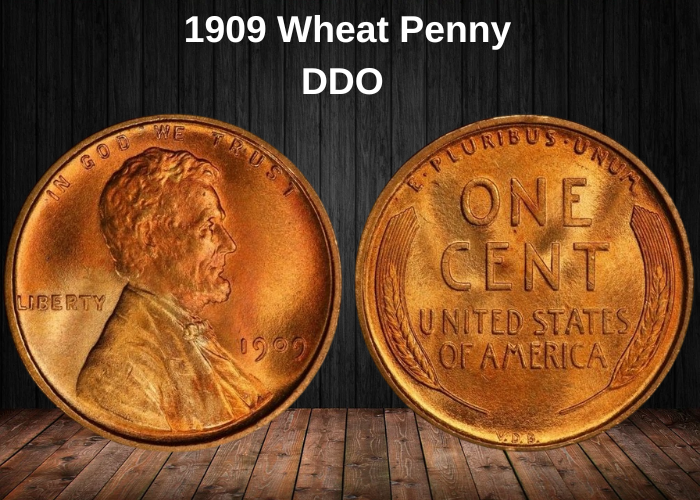
A double die error (DDO) is present in both coin variations—those with and without VDB initials—resulting from a minting issue where the design elements are doubled. This error is most noticeable on the LIBERTY inscription. Experts estimate that only around 500 VDB pennies minted in 1909 have this error.
The typical price for a DDO 1909 VDB penny is around $1,000, although auction records show higher values. The most expensive known sale of a 1909 VDB MS 67+ red penny with the DDO error occurred in 2023, where it was sold for an impressive $31,200.
RPM (S over S mint mark)
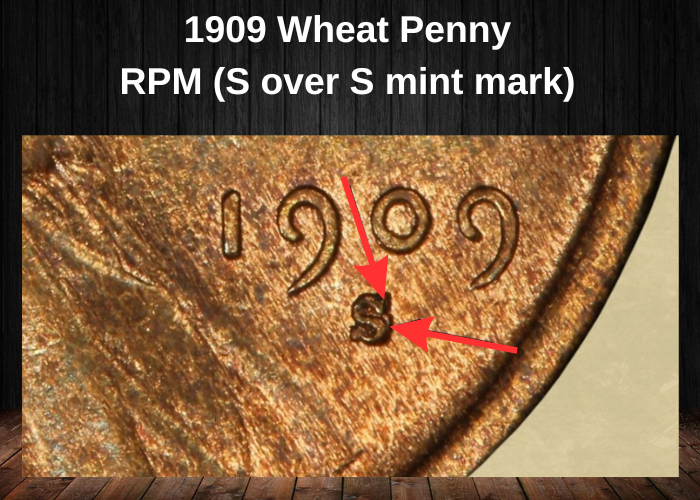
Some 1909 Wheat pennies feature a re-punched mint mark (RPM) error, specifically an “S over horizontal S” on the obverse. This mistake occurred when the S mint mark was incorrectly struck the first time, and a second impression was made to correct it.
These error coins typically command about 10% higher prices than standard 1909-S pennies. However, auction records show that some have sold for much more:
- A brown RPM penny sold for $875 in 2018.
- A red-brown RPM penny reached $1,668 in 2006.
- The most expensive red RPM penny, graded MS 67, was sold at auction in 2022 for $32,900.
Other errors
Besides the two most well-known 1909 penny errors—the double die (DDO) and re-punched mint mark (RPM)—some coins exhibit a combination of two errors, making them even more unique and valuable. Examples include:
- Off-center strike with doubling error – A misaligned strike combined with a doubled design element, making the coin highly collectible.
- Die chip with doubled die error – A coin featuring both a die chip (a small raised metal flaw) and a doubled design due to a minting issue.
These rare error combinations can significantly increase a penny’s value, depending on the severity and visibility of the imperfections.
FAQ about the 1909 Wheat Penny
What makes a 1909 penny rare?
While most circulated 1909 pennies are common, the VDB varieties and high-grade specimens are considered rare. Among them, the 1909-S VDB penny is the most sought-after due to its low mintage and historical significance.
Which 1909 penny is worth the most?
Some high-grade and rare 1909 Wheat pennies have fetched astonishing prices at auctions:
- 1909 PR 67+ RB (VDB) – $258,500 (2014)
- 1909-S MS 67 RD (VDB) – $168,000 (2022)
- 1909 PR 66 RD (VDB) – $70,500 (2019)
- 1909-S MS 67 RD – $69,000 (2004)
- 1909 MS 68 RD (VDB) – $56,400 (2021)
- 1909-S/Horizontal S MS 67 RD – $32,900 (2022)
How much is a 1909 Philadelphia penny worth?
The 1909 Philadelphia penny comes in two versions—with and without the VDB initials. Their value depends on color (brown, red-brown, or red) and grade:
- Brown: $1.25 – $54
- Red-Brown: $17 – $160
- Red: $45 – $1,800
- VDB Brown: $3 – $450
- VDB Red-Brown: $22 – $22,000
- VDB Red: $40 – $66,000
What is the most expensive Wheat penny ever sold?
The highest-selling Wheat cents include:
- 1944-S MS 66 Steel – $408,000 (2021)
- 1958 DDO MS 64 RD – $336,000 (2018)
- 1909 VDB PR 67+ RD – $258,500 (2014) (Most valuable 1909 penny)
- 1943-D Bronze MS 64 BN – $840,000 (2021) (Most expensive Wheat penny overall)
These record-breaking sales highlight the importance of rarity, condition, and unique errors in determining a 1909 penny’s worth.



















































